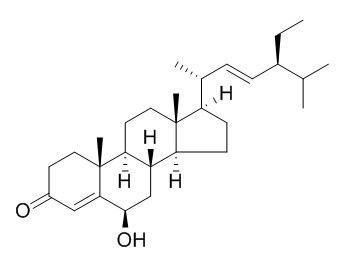6-Hydroxystigmasta-4,22-dien-3-one
6β-Hydroxystigmasta-4,22-dien-3-one exhibits in vitro antibacterial activity; it also shows antioxidant activity, the value of IC50 toward DPPH is 233.4 ± 0.28 uM.
Inquire / Order:
manager@chemfaces.com
Technical Inquiries:
service@chemfaces.com
Tel:
+86-27-84237783
Fax:
+86-27-84254680
Address:
1 Building, No. 83, CheCheng Rd., Wuhan Economic and Technological Development Zone, Wuhan, Hubei 430056, PRC
Providing storage is as stated on the product vial and the vial is kept tightly sealed, the product can be stored for up to
24 months(2-8C).
Wherever possible, you should prepare and use solutions on the same day. However, if you need to make up stock solutions in advance, we recommend that you store the solution as aliquots in tightly sealed vials at -20C. Generally, these will be useable for up to two weeks. Before use, and prior to opening the vial we recommend that you allow your product to equilibrate to room temperature for at least 1 hour.
Need more advice on solubility, usage and handling? Please email to: service@chemfaces.com
The packaging of the product may have turned upside down during transportation, resulting in the natural compounds adhering to the neck or cap of the vial. take the vial out of its packaging and gently shake to let the compounds fall to the bottom of the vial. for liquid products, centrifuge at 200-500 RPM to gather the liquid at the bottom of the vial. try to avoid loss or contamination during handling.
Food Engineering Progress2019, 23(3)209-216
J Nutr Biochem.2022, 107:109064.
Food Chem.2024, 458:140201.
Journal of Life Science2017, 233-240
J Sep Sci.2020, 201901140
Front Pharmacol.2024, 15:1455805.
Preprints2024, 2085.v1
Toxicol Appl Pharmacol.2022, 434:115815.
Pharmaceuticals (Basel).2024, 17(9):1130.
ACS Food Sci. Technol.2023, 3(2):273-282.
Related and Featured Products
Fitoterapia. 2003 Feb;74(1-2):159-63.
Antibacterial activity and cytotoxicity of extractives from Uvaria hamiltonii stem bark.[Pubmed:
12628415]
METHODS AND RESULTS:
The extracts as well as piperolactum C, goniopedaline, 6beta-hydroxystigmasta-4,22-dien-3-one(6-Hydroxystigmasta-4,22-dien-3-one ) and a mixture of cis- and trans-4-hydroxymelleins obtained from Uvaria hamiltonii stem bark exhibited mild to moderate in vitro antibacterial activity.
CONCLUSIONS:
The results obtained were compared with a standard antibiotic, kanamycin. In a brine shrimp lethality bioassay the pet-ether, dichloromethane, methanol extracts and a major alkaloid, piperolactum C were found to exhibit mild to moderate cytotoxicity.
Int. J.Pharm.Pharm. Sci.,2014,6(8):350-4.
Radical scavenging activity of triterpene steroids from stem of Polygonum pulchrum Bl[Reference:
WebLink]
METHODS AND RESULTS:
Four triterpene steroids; namely, (1) 6Î2-hydroxystigmasta-4,22-dien-3-one(6-Hydroxystigmasta-4,22-dien-3-one ), (2) stigmasterol,(3) stigmasta-4,22-dien-3-one, and (4) ergosterol peroxide, were isolated and identified from stems of P. pulchrum Bl. The antioxidant activities of all compounds were indicated by IC50 value of the compounds. The values of IC50 (μM) of6 Î2-hydroxystigmasta-4,22-dien-3-one, stigmasterol, Stigmasta-4,22-dien-3-on,ergosterol peroxide, and vitamine C (standard) toward DPPH were obtained at 233.4 ± 0.28; 372.3 ± 0.33; 144.80 ± 0.24; 1083.1 ± 0.38; and 68.9 ± 0.12, respectively.
CONCLUSIONS:
We found that Stigmasta-4,22-dien-3-onewas the most active compound toward DPPH.
Zhongguo Zhong Yao Za Zhi. 2009 Mar;34(6):712-4.
Chemical constituents from Hedyotis diffusa.[Pubmed:
19624011]
METHODS AND RESULTS:
The compounds were isolated and purified by various chromatographic techniques and identified by their physicochemical properties and spectral data. Eight compounds had been reported in last paper, and this time eight more compounds were isolated and identified as 6-Hydroxystigmasta-4,22-dien-3-one (1), 3-hydroxystigmasta-4,22-dien-7-one (2), 2-hydroxy-3-methylanthraquinone (3), 2,6-dihydroxy-3-methyl-4-methoxyanthraquinone (4), iso-scutellarein (5), isoetin (6), aesculetin (7), gypsogenic acid (8).
CONCLUSIONS:
Compounds 1-3, 5-8 were obtained from the genus Hedyotis for the first time.



